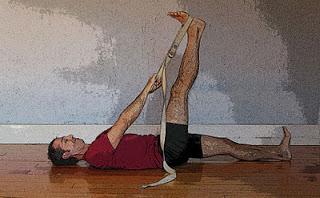Reclined Leg Stretch
Last week I looked at the concept of “compression” both as a perceivable event in your body and as a potential problem for your body when doing asana (see Tension Versus Compression). After that post, one of our readers requested information about the other sensation producer, muscle tension, and the usually desirable event that occurs when we do asana, stretching in the muscle.In the vast majority of our yoga classes in the US, we are continually asked to notice the sensations arising from the various yoga asana as we perform them. We are encouraged to find our “edge,” a place or perception of muscle stretch before which we don’t feel much, and beyond which we feel too much or begin to encounter pain. We are led to believe that stretching our tight muscles is highly desirable, but often are not clearly told where the “finish line” of this process might be. So how much stretch is the right amount? How much is too much? And how can we tell the difference? I have an opinion on all of these questions, but I took a look around to see if there was any objective evidence that might give more credence to my opinions.
The first interesting article I came across was How Necessary is Stretching? a New York Times article from 2009. Here Gretchen Reynolds reported on at some new information about stretching that had just been discovered. One study looked at a group of runners at a university in Nebraska. Researchers measured the runners' hamstring flexibility, then compared hamstring flexibility to a measure of their success as runners (known as “running economy”). They found that runners with tighter hamstrings were actually faster and stronger runners. Reynolds noted that, “In fact, the latest science suggests that extremely loose muscles and tendons are generally unnecessary (unless you aspire to join a gymnastics squad), may be undesirable and are, for the most part, unachievable, anyway.” She went on to quote a sports medicine expert:
“To a large degree, flexibility is genetic,” says Dr. Malachy McHugh, the director of research for the Nicholas Institute of Sports Medicine and Athletic Trauma at Lenox Hill Hospital in New York and an expert on flexibility. You’re born stretchy or not. “Some small portion” of each person’s flexibility “is adaptable,” McHugh adds, “but it takes a long time and a lot of work to get even that small adaptation…””This made me consider what purpose my yoga “stretching” was for. I tend to think that stretching is going to give me more success and less discomfort in performing my asana. The above article did mention one benefit of a regular stretching of the muscles. If done regularly, even if the length of your muscle does not change much, your perception of the intensity of the stretch sensation diminishes. In other words, you don’t feel so tight anymore. So stretching regularly will make your asana more comfortable, and if you are practicing asana to prepare for seated meditation or pranayama, you will also find it easier to sit comfortably on the floor.
For healthy aging, stretching is important for maintaining flexibility as you age. Without regular stretching, your muscles will become stiffer, potentially interfering with your ability to go about the normal activities of daily life, including dressing yourself, driving, walking unassisted and even getting in and out of a chair (see Transferring and Yoga), and can impact your ability to balance. For all these reasons, stretching is very beneficial for you whether or not your muscles actually become more flexible.
Before I go much further with that train of thought, let’s look at what else I found. When a muscle is stretched, it not just the muscle cells themselves that do the elongating, but also the connective tissue or fascia that surrounds and penetrates each muscle of the body. Where the muscle has pretty amazing ability to elongate and contract and change size dramatically, the ability of the fascia is more limited, even when it contains some elastic cells. And when the connective tissue is over-stretched, it can lose its supportive properties for the muscles and lead to increased chance of the muscle itself getting micro-tears that heal more slowly. In addition to the fascia, the other connective tissues, such as the tendons that attach the muscle to bone, are more vulnerable to injury as well.
So, I think common sense regarding stretching muscles is to work up to a point discomfort, but not into frank pain. Try to get the sense of stretch in the center of a long muscle and try to avoid sensation closer to its bony attachment at (or near) the joint. On occasion, you will know you have overdone it by the sudden quality of pain that accompanies your stretch, but often you won’t know until the next day, when inflammation sets in and the pain is there more persistently. Shoot for taking your stretches slowly and mindfully, keeping your personal goals in mind as you work in your poses.
And as Paul Ingraham points out in The Unstretchables: Eleven Major Muscles You Can’t Stretch, No Matter How Hard You Try, some muscles aren’t actually stretchable the way muscles like the hamstrings—which are quite literally made for stretching—are. I know there are a lot of thoughts on this topic out there, so feel free to add your insights here. I believe in our collective wisdom!
Subscribe to Yoga for Healthy Aging by Email ° Follow Yoga for Healthy Aging on Facebook and Twitter ° To order Yoga for Healthy Aging: A Guide to Lifelong Well-Being, go to Amazon, Shambhala, Indie Boundor your local bookstore.
Follow Baxter Bell, MD on YouTube, Facebook, and Instagram. For upcoming workshops and retreats see Baxter's Workshops and for info on Baxter see baxterbell.com.


